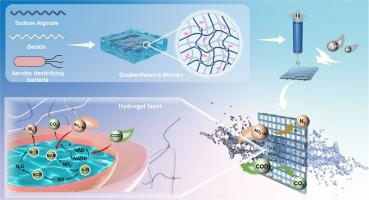当前位置:
X-MOL 学术
›
Water Res.
›
论文详情
Our official English website, www.x-mol.net, welcomes your
feedback! (Note: you will need to create a separate account there.)
Construction of Stable Niches for Denitrifiers using 3D Bioprinting for Efficient Nitrogen Removal
Water Research ( IF 11.4 ) Pub Date : 2025-05-27 , DOI: 10.1016/j.watres.2025.123916
Yinuo Liu, Tianyang Zhao, Yichen Wu, Jiaojiao Niu, Chunfang Chao, Yingxin Zhao
Water Research ( IF 11.4 ) Pub Date : 2025-05-27 , DOI: 10.1016/j.watres.2025.123916
Yinuo Liu, Tianyang Zhao, Yichen Wu, Jiaojiao Niu, Chunfang Chao, Yingxin Zhao

|
The denitrification process is the core of biological nitrogen removal technology, but its efficacy is limited by the fragile ecological niche of denitrifying bacteria. This study successfully created three-dimensional (3D) denitrification living materials by the controllable and biocompatible 3D bioprinting technology, enabling the construction of artificial 3D microscale structures that facilitate microenvironments for the efficient dynamic reactions of denitrifying bacteria. By developing the double network structure of sodium alginate–gelatin, the bioink with easy extrusion and robust mechanical properties was obtained. Subsequently, the denitrifying bacteria were arranged in three dimensions through a 3D bioprinting platform, and the living materials characterized by precisely controlled three-dimensional morphology and excellent dynamic metabolism were created. The results further indicated that a stable denitrifying bacterial niche was successfully established within 3D living materials, resulting in a significant improvement in the denitrification performance. Additionally, the 3D living materials still maintained high bacterial activity at the low temperatures, showing their potential for repeated use and tolerance to adverse conditions. This study demonstrated the potential of 3D bioprinting technology in constructing living materials with ideal bacterial niches for efficient wastewater treatment, thereby offering novel avenues for addressing the water pollution concerns.
中文翻译:

使用 3D 生物打印为反硝化剂构建稳定的生态位以实现高效脱氮
反硝化过程是生物脱氮技术的核心,但其功效受到反硝化细菌脆弱的生态位的限制。本研究通过可控和生物相容性的 3D 生物打印技术成功创建了三维 (3D) 反硝化生物材料,从而能够构建人工 3D 微尺度结构,为反硝化细菌的高效动态反应提供微环境。通过开发海藻酸钠-明胶的双网络结构,获得了易于挤出和稳定力学性能的生物墨水。随后,通过 3D 生物打印平台将反硝化细菌进行三维排列,并创造了具有精确控制的三维形态和优异动态代谢特征的生物材料。结果进一步表明,在 3D 生物材料中成功建立了稳定的反硝化细菌生态位,导致反氮化性能显着提高。此外,3D 生物材料在低温下仍保持高细菌活性,显示出它们可重复使用的潜力和对恶劣条件的耐受性。这项研究证明了 3D 生物打印技术在构建具有理想细菌生态位的活体材料以实现高效废水处理方面的潜力,从而为解决水污染问题提供了新的途径。
更新日期:2025-05-28
中文翻译:

使用 3D 生物打印为反硝化剂构建稳定的生态位以实现高效脱氮
反硝化过程是生物脱氮技术的核心,但其功效受到反硝化细菌脆弱的生态位的限制。本研究通过可控和生物相容性的 3D 生物打印技术成功创建了三维 (3D) 反硝化生物材料,从而能够构建人工 3D 微尺度结构,为反硝化细菌的高效动态反应提供微环境。通过开发海藻酸钠-明胶的双网络结构,获得了易于挤出和稳定力学性能的生物墨水。随后,通过 3D 生物打印平台将反硝化细菌进行三维排列,并创造了具有精确控制的三维形态和优异动态代谢特征的生物材料。结果进一步表明,在 3D 生物材料中成功建立了稳定的反硝化细菌生态位,导致反氮化性能显着提高。此外,3D 生物材料在低温下仍保持高细菌活性,显示出它们可重复使用的潜力和对恶劣条件的耐受性。这项研究证明了 3D 生物打印技术在构建具有理想细菌生态位的活体材料以实现高效废水处理方面的潜力,从而为解决水污染问题提供了新的途径。


















































 京公网安备 11010802027423号
京公网安备 11010802027423号